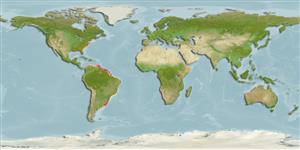Classification / Names
Populärnamn | synonymer | Catalog of Fishes(Släkte, Arter) | ITIS | CoL | WoRMS | Cloffa
>
Scombriformes (Mackerels) >
Stromateidae (Butterfishes)
Etymology: Peprilus: Greek, peprilos, paprax, certain fish from Tracia.
Environment: milieu / climate zone / depth range / distribution range
Ekologi
marina; brackvatten; djupintervall 13 - 136 m (Ref. 116249). Tropical
Western Atlantic: French Guiana and Argentina
Size / Vikt / Age
Maturity: Lm ? range ? - ? cm
Max length : 22.0 cm TL hane/ej könsbestämd; (Ref. 124480); publicerad maxvikt: 66.80 g (Ref. 118626)
Short description
Morfologi | Morfometri
Taggstrålar i ryggfenan (totalt): 3 - 5; Mjukstrålar i ryggfenan (totalt): 39-45; Taggstrålar i analfenan 3-4; Mjukstrålar i analfenan: 36 - 41; Ryggkotor: 28 - 29. This species is distinguished from its congeners (except P. xanthurus) by having the following characters: precaudal vertebrae 11?12 (vs. 13 or more, rarely 12); total vertebrae 28?29 (vs. 30 or more in P. medius, P. ovatus, P. simillimus and P. snyderi); body height 58.5?79.0% SL (vs. 33.0?52.% SL in P. burti, P. simillimus, P. snyderi, P. ovatus and P. triacanthus); without series of pores along the front half of body under the dorsal fin (vs. 17?25 in P. triacanthus); a moderately falcate dorsal fin (vs. not falcate in P. triacanthus, or conspicuously falcate in P. paru); specimens larger than 9.0 cm SL, has an extremely falcate anal fin (vs. not falcate or moderately falcate in P. burti, P. simillimus, P. snyderi, P. ovatus and P. triacanthus); further distinguished from sympatric P. xanthurus by the lack of a conspicuous dark spot over the eyes, from snout to nape (vs. a conspicuous dark spot over the eyes, especially distinct in fresh specimens); in specimens smaller than 11.0 cm SL, orbital diameter is 1.6?5.0 in anal-fin height (vs. 5.1?8.0); in specimens larger than 10.9 cm SL, orbital diameter is 3.2?5.2 in anal-fin height (vs. 5.5?9.2), 2.9?3.8 in pectoral-fin height (vs. 3.9?5.9), and 0.8?1.4 in post-orbital length (vs. 1.5?2.3); further distinguished from P. paru by having a moderately long to short dorsal fin and relatively long caudal fin lobe, with length of lower lobe more than 1.2 times the length of the dorsal fin (vs. 1.2 times the length or less) (Ref. 116249).
Occurs in estuarine and coastal marine waters at depths of up to 136 meters. Probably does not form large schools for though it is common in the catches of artisanal fisheries (notably in Brazil), it is always in small numbers (Ref. 116249).
Life cycle and mating behavior
Könsmognad | Reproduktion | Lek | Ägg | Fecundity | Larver
Marceniuk, A.P., R. Caires and R. Siccha-Ramirez, 2016. Review of the harvestfishes, genus Peprilus (Perciformes: Stromateidae), of the Atlantic coast of South America. Zootaxa 4098(2):311-332. (Ref. 116249)
IUCN Red List Status (Ref. 130435)
Threat to humans
Harmless
Human uses
Ytterligare information
PopulärnamnsynonymerMetabolikPredatorerEkotoxikologiReproduktionKönsmognadLekSpawning aggregationFecundityÄggEgg development
referenserVattenbrukVattenbruksprofilAvelslinjerGenetikElectrophoresesÄrftlighetSjukdomarBehandlingNutrientsMass conversion
MedarbetareBilderStamps, Coins Misc.LjudCiguateraHastighetSimsättGälytaOtolithsHjärnstorlekSyn
Verktyg
Special reports
Download XML
Internet-källor
Estimates based on models
Phylogenetic diversity index (Ref.
82804): PD
50 = 0.5020 [Uniqueness, from 0.5 = low to 2.0 = high].
Bayesian length-weight: a=0.01622 (0.00965 - 0.02725), b=2.93 (2.79 - 3.07), in cm total length, based on LWR estimates for this species & Genus-body shape (Ref.
93245).
Trofisk nivå (Ref.
69278): 3.9 ±0.2 se; based on size and trophs of closest relatives
Resiliens (Ref.
120179): Hög, lägsta populationsfördubblingstid mindre än 15 månader (Preliminary K or Fecundity.).
Fishing Vulnerability (Ref.
59153): Low vulnerability (12 of 100).
